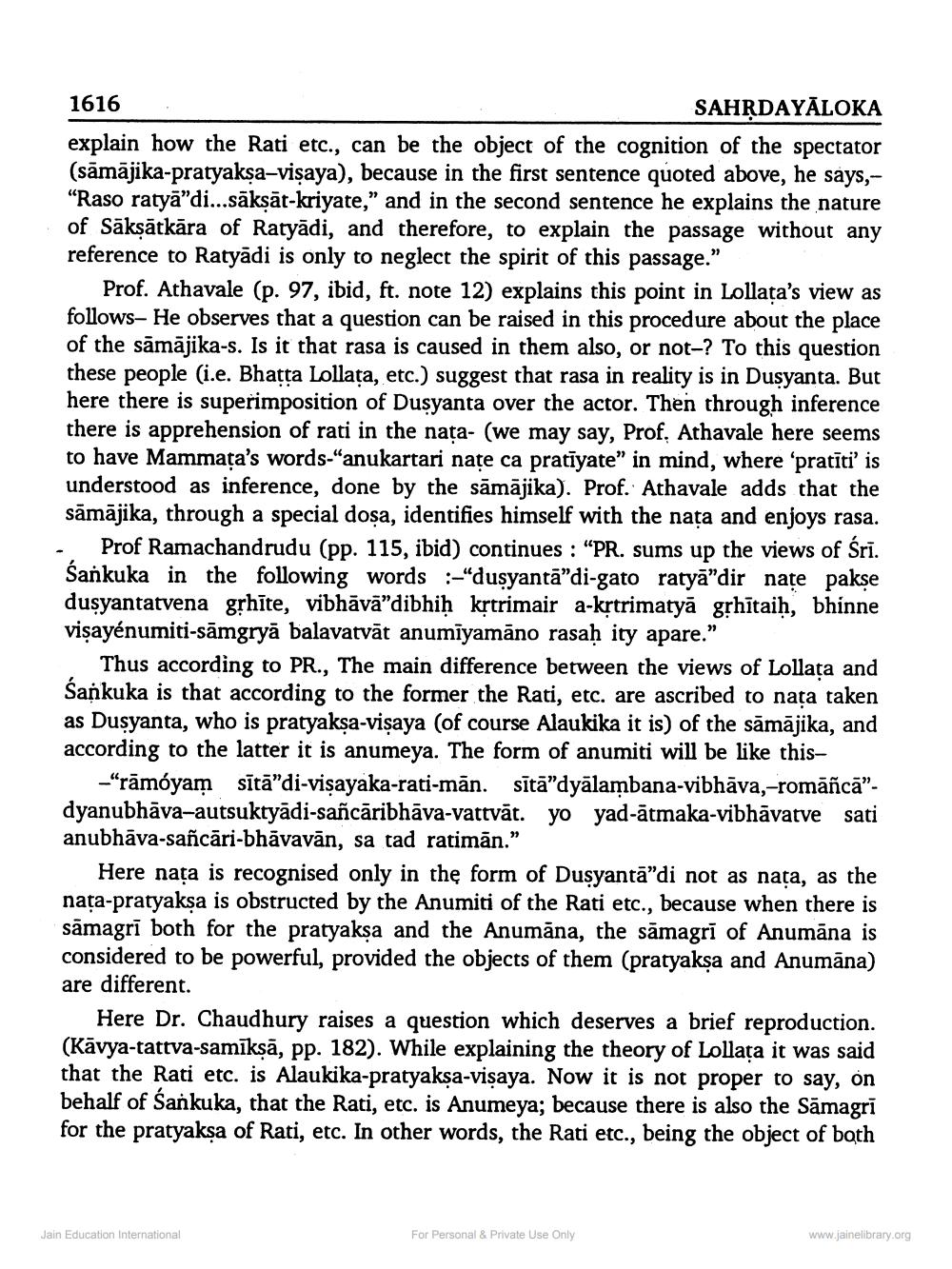________________
1616
SAHDAYĀLOKA explain how the Rati etc., can be the object of the cognition of the spectator (sāmājika-pratyaksa-visaya), because in the first sentence quoted above, he says,“Raso ratyā"di...sāksāt-kriyate," and in the second sentence he explains the nature of Sākṣātkāra of Ratyādi, and therefore, to explain the passage without any reference to Ratyādi is only to neglect the spirit of this passage."
Prof. Athavale (p. 97, ibid, ft. note 12) explains this point in Lollata's view as follows- He observes that a question can be raised in this procedure about the place of the sāmājika-s. Is it that rasa is caused in them also, or not-? To this question these people (i.e. Bhatta Lollata, etc.) suggest that rasa in reality is in Dusyanta. But here there is superimposition of Dusyanta over the actor. Then through inference there is apprehension of rati in the nata- (we may say, Prof. Athavale here seems to have Mammata's words-"anukartari nate ca pratīyate" in mind, where 'pratiti' is understood as inference, done by the sāmājika). Prof. Athavale adds that the sāmājika, through a special dosa, identifies himself with the nata and enjoys rasa. - Prof Ramachandrudu (pp. 115, ibid) continues : “PR. sums up the views of Sri. Sankuka in the following words :-"dusyantā"di-gato ratyā"dir națe pakse dusyantatvena grhīte, vibhāvā"dibhih krtrimair a-krtrimatyā grhītaih, bhinne visayénumiti-sāmgryā balavatvāt anumīyamāno rasaḥ ity apare.”
Thus according to PR., The main difference between the views of Lollata and Sankuka is that according to the former the Rati, etc. are ascribed to nata taken as Dusyanta, who is pratyaksa-visaya (of course Alaukika it is) of the sāmājika, and according to the latter it is anumeya. The form of anumiti will be like this,
-"rāmóyam sītā"di-visayaka-rati-mān. sītā"dyālambana-vibhāva,-romāñcā”dyanubhāva-autsuktyādi-sancāribhāva-vattvāt. yo yad-ātmaka-vibhāvarve sati anubhāva-sañcāri-bhāvavān, sa tad ratimān.”
Here nata is recognised only in the form of Dusyantā"di not as nata, as the nata-pratyaksa is obstructed by the Anumiti of the Rati etc., because when there is sāmagrī both for the pratyaksa and the Anumāna, the sāmagrī of Anumāna is considered to be powerful, provided the objects of them (pratyaksa and Anumāna) are different.
Here Dr. Chaudhury raises a question which deserves a brief reproduction. (Kāvya-tattva-samīksā, pp. 182). While explaining the theory of Lollata it was said that the Rati etc. is Alaukika-pratyaksa-visaya. Now it is not proper to say, on behalf of Sankuka, that the Rati, etc. is Anumeya; because there is also the Sāmagri for the pratyaksa of Rati, etc. In other words, the Rati etc., being the object of both
Jain Education International
For Personal & Private Use Only
www.jainelibrary.org




